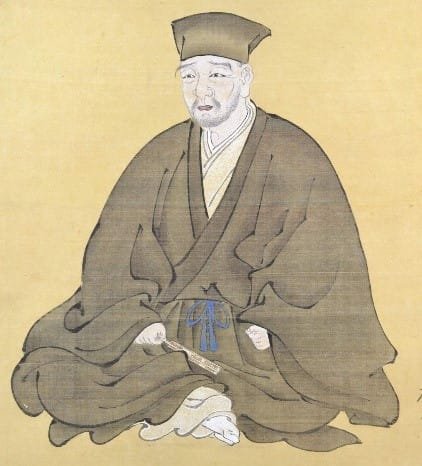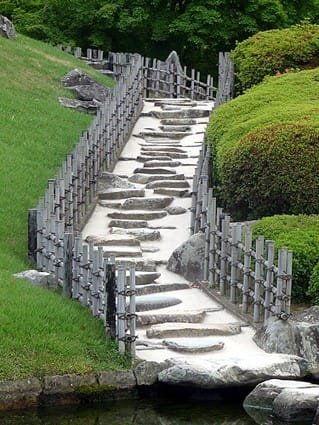In the Japanese style of gardening, each aspect of the landscape design is seen as an important part of the overall functionality and aesthetic appeal of the final composition.
Stepping stones Tobi-Ishi are considered to be either 40% practical and 60% scenic or 60% practical and 40% scenic. In any case, the way Tobi-Ishi stepping stones are arranged helps to create unity in the garden landscape, no matter if it comes to a bonsai garden or just any other type of garden that follows the basic principles of Japanese tradition and aesthetics.
Tobi-Ishi Stepping Paths: The Beginning

Although the very beginning of the use of stepping stones in a Japanese style of gardening is still laced in mystery, it is widely believed that the first to introduce the Tobi-Ishi stepping stones path was none other but the tea master Sen no Rikyu (千利休) who was born in 1522 and passed away in 1591.
Commonly referred to as the Greatest Tea Master, Sen no Rikyi along with his teacher Takeno Jo-o were pioneers in inaugurating the core concepts and spirit of wabi-sabi into the traditional tea ceremony.
Video by: Tasty Japan -茶道 – Japanese Tea Ceremony –
Source: youtube.com
Sen no Rikyi disliked the way his sandals became dirty when walking upon the moss or dirt of the tea garden, especially after rain when the bare soil would often become muddy.
Nonetheless, Sen no Rikyi further recommended that Tobi-Ishi stepping stones should stand 6cm higher than the ground.
Unlike Sen no Rikyi, other notable tea masters who lived after him recommended a different height of the stepping stones from the ground. According to Furuta Oribe, it is best if stepping stones are 5 cm above the ground. According to Kobori Enshu, stepping stones should be placed at only 3 cm from the ground.
What are Tobi Ishi Stepping Stones Used for?

As briefly mentioned above, stepping stones play a key role in the Japanese style of gardening because they combine functionality and harmony of the experience achieved through walking down the Tobi-Ishi path.
Translated from Japanese, “tobi-ishi” (飛石) literally means “Skipping stones” or “Flying stones.”
This translation beautifully explains the very purpose of using stepping stones in landscape design – making the visitors make tiny jumps in order to get from one stone to the other. This practice does not intend to make the mission of the visitors difficult due to the fact he/she needs to be extra careful when walking on the tobi-ishi paved surface. Instead, it is in the required extra attention where the true wisdom of Japanese stepping stones resides.
As stepping stones “force” visitors to pay much more attention when walking, this influences the way the garden is experienced.
Nonetheless, a stepping stone path constrains the number of people who can walk comfortably right next to each other and possibly keeping a conversation going.
However, as walking on a tobi-ishi path obliges visitors to walk one after the other (in line), this takes a place for truly sinking into the delightful perception of being able to “arrive” in the garden.
By arriving in the garden, Japanese Zen masters refer to the process of mentally preparing for the tea ceremony by leaving all the burden of everyday life behind you while you are focused on jumping from one stepping stone to the other and literally clarifying your thoughts and state of mind – both consciously and subconsciously.
Video by: krussell2008 – Japanese Gardens#1 HD
Source: youtube.com
Japanese Tea Gardens and the Key Element of Stepping Stones

Most of the people who are new to the Japanese style of gardening, tradition, culture, and/or aesthetic tend to think that a Japanese tea garden is a place where one drinks tea in a garden. However, this is not the true meaning of a Japanese tea garden.
Instead, a Japanese tea garden (“roji” – 露地 ) refers to a specific type of garden that possesses several equally important key elements, one of which being stepping stones tobi-ishi.
Other elements of a Japanese tea garden include crouching water basin (tsukubai), Japanese lanteren (toro), and a waiting place (machi-ai).
Being the very passage to the teahouse where the tea ceremony is held, Japanese tea gardens can be compared to a deeply symbolic and spiritual path that one needs to walk in order to experience the true spirit of the tea ceremony.
Therefore, going through the passage from the noisy, stressful outside world to the silent, content inner world of the teahouse is further enhanced by an element of stepping stones as walking on the tobi-ishi path can help to achieve peace of mind before starting the tea ceremony.
The very arrangements of stepping stones can control the pace of proceeding through the garden, thus, setting the mood of the visitors and varying from formal, informal, and semi-formal.
Apart from being referred to as Tobi-Ishi, stepping stones can also be referred to as nori-no-ishi (乗の石), implying the meaning that the stones will show the visitors exactly where to go. Meanwhile, trump stones (yaku-ishi 役石) are used for the purpose of highlighting the most prominent features of the garden scenery, such as the guests’ entrance and the water basin (tsukubai), among others.
Below are some of the different styles in which stepping stones can be arranged based on the Japanese style of gardening, the desired functionality and aesthetic appeal of the scenery, as well as the desired garden walk experience.
- Straight line (chokuuchi 直打)
- Two stone set (niren’uchi 二連打)
- Three stone set (sanren’uchi 三連打)
- Five stone set (goren’uchi 五連打)
- Seven/five/ three stone pattern (shichi-go-san 七五三 )
- Three and four stone set in a zig-zag pattern (shisankuzushi 四三崩)
- Extended zig-zag pattern (gan’uchi 雁打)
- Fallen leaves (konohauchi 木の葉打)
- The oblong stone set (tanzakuuchi 短冊打 )
Final Thoughts
Japanese stepping stones Tobi-Ishi used in Japanese style gardening create a path that is not merely practical but also highly spiritual as it embodies the Japanese understanding of the way a tea ceremony needs to be approached – with a clean mind and a clean soul. In a similar manner, stepping stones can be also used to create unity in the bonsai landscape.


